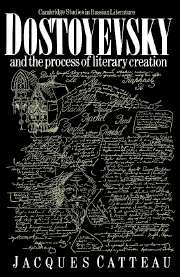Book contents
- Frontmatter
- Contents
- Preface to the English edition
- List of abbreviations
- General editor's note on transliteration and references
- General introduction
- PART I The creative environment
- Introduction
- 1 Forms of creativity in embryo
- 2 The heritage
- 3 The heritage: literature
- 4 The heritage: history and philosophy
- 5 Illness
- 6 Money
- PART II The process of creation
- Part III Time and space in the world of the novels
- Conclusion
- Notes
- Select bibliography
- Index of names
Introduction
Published online by Cambridge University Press: 18 December 2009
- Frontmatter
- Contents
- Preface to the English edition
- List of abbreviations
- General editor's note on transliteration and references
- General introduction
- PART I The creative environment
- Introduction
- 1 Forms of creativity in embryo
- 2 The heritage
- 3 The heritage: literature
- 4 The heritage: history and philosophy
- 5 Illness
- 6 Money
- PART II The process of creation
- Part III Time and space in the world of the novels
- Conclusion
- Notes
- Select bibliography
- Index of names
Summary
However independent it may appear to the reader, every literary work is created in specific circumstances. The universality, the perennial quality later recognised in it, is rooted in a definite time, a specific environment, in the living flesh of the many who created it. Lansonian criticism, the traditional biographical school, postulates that a work cannot be approached seriously without first studying the surroundings in which the creative act took place, in other words, without studying the author in all his individual, social, biological and spiritual aspects. This provides a safeguard against whimsical interpretations and makes the work of fiction credible as part of the experience of a real man. Even psychoanalytical criticism, dizzy from building its own towers of Babel and its inversion of the usual scholarly procedures, using the works to find out about their creator, is now reforming itself and, renovated under the name of psychocriticism, is checking its discoveries, based on the comparison of texts, against the good old biographical sources.
However, traditional criticism juxtaposes the author and the work, omitting the creative act which binds the two. Certainly there are gangways leading from one to the other; correlations are noted, but the result is still a juxtaposition of two mirrors showing images which are occasionally in agreement but for the most part very different, as the work seems to escape from and surpass its creator.
In this static approach, the creative function, the act that connects the man and the work in a functional relationship, is forgotten, although it is the essential point of this critical method.
- Type
- Chapter
- Information
- Dostoyevsky and the Process of Literary Creation , pp. 7 - 8Publisher: Cambridge University PressPrint publication year: 1989



